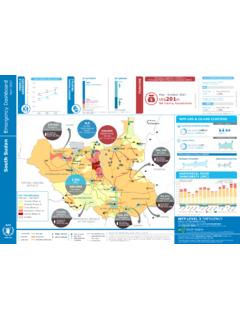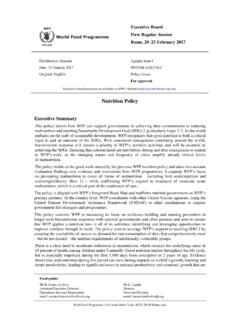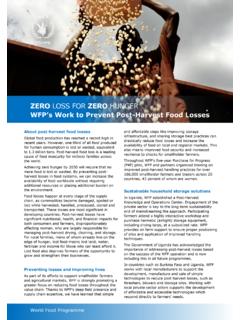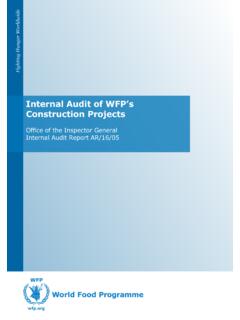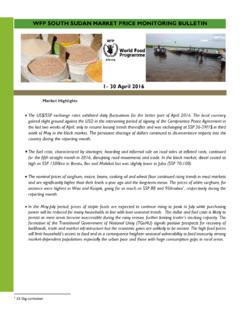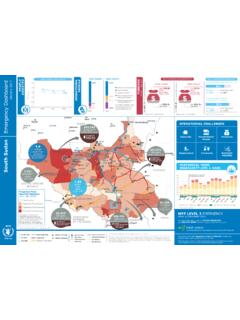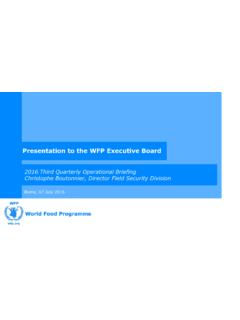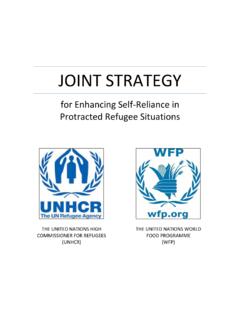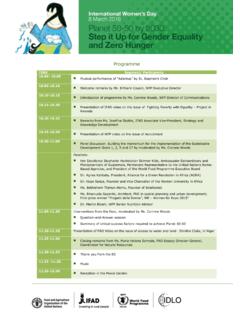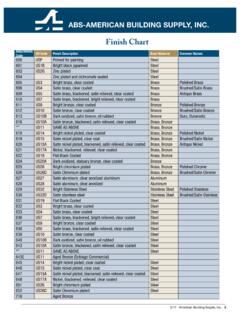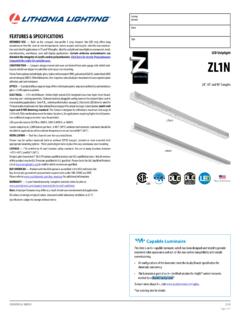Transcription of Market Analysis Framework
1 Market Analysis Framework Tools and Applications for Food Security Analysis and Decision-Making December 2011 1 Market Analysis Framework December 2011, World Food Programme Food Security Analysis Service (ODXF) This Guidance Sheet was prepared by the United Nations World Food Programme for use by staff and partners. All rights are reserved. Reproduction is authorized, except for commercial purposes, provided that WFP is acknowledged as the original source. United Nations World Food Programme Via Cesare Giulio Viola 68/70 Parco de Medici 00148 Rome, Italy Market Analysis Framework provides guidance on tools that can help to carry out a Market Analysis for food security assessments, programming and decision-making. For more information, please contact: Joyce Luma, Chief, Food Security Analysis Service (ODXF) Issa Sanogo, (MAF Project Coordinator) Senior Programme Advisor, Team Leader Market Analysis (ODXF) The WFP Food Security Analysis Service (ODXF) wishes to thank the Federal Ministry for Economic Cooperation and Development of Germany, which provided financial support for the development of this guidance.
2 It would also like to acknowledge that this guide benefited greatly from the inputs of Sharon Osterloh, Jacqueline Frize and Blake Audsley and from the comments provided by various WFP colleagues. 2 CONTENTS 1. INTRODUCTION TO THE Framework .. 5 2. CONCEPTUALIZING MARKETS .. 6 Defining markets .. 6 Defining markets 7 Linking Market Analysis to food security Analysis .. 8 3. MICRO-LEVEL TOOLS .. 10 Income Analysis .. 11 Labour Market Analysis .. 12 Shock scenarios and elasticity .. 13 Net buyer/seller status .. 14 4. MESO-LEVEL TOOLS .. 15 Structure-Conduct-Performance Analysis .. 15 Value chain Analysis .. 21 Cost-efficiency Analysis .. 21 5. MACRO-LEVEL TOOLS .. 25 6. SELECTING AN APPROACH AND PRIORTIZING INFORMATION NEEDS .. 28 7. FORMULATING RESPONSE RECOMMENDATIONS AND CONCLUSIONS .. 31 3 List of figures FIGURE 1. MARKETS IN THE WFP FOOD SECURITY AND NUTRITION Framework 9 FIGURE 2.
3 LEVEL OF Analysis OF VARIOUS Market Analysis TOOLS 10 FIGURE 3. DIMENSIONS OF EFFECTIVE DEMAND Analysis 11 FIGURE 4. CORRELATION BETWEEN THE IPP AND IMPORTS OF RICE 23 FIGURE 5. Market Analysis TOOLS: LEVELS OF Analysis AND TIME REQUIREMENTS 33 List of tables TABLE 1. SUMMARY OF Market Analysis TOOLS AVAILABLE 29 TABLE 2. CHARACTERISTICS OF TWO SUMMARY TOOLS WITH RESPONSE Analysis COMPONENTS 32 4 ACRONYMS CFSVA Comprehensive Food Security and Vulnerability Analysis CPI Consumer Price Index CV Coefficient of variation EFSA Emergency Food Security Assessment EMMA Emergency Market Mapping and Analysis FAO Food and Agriculture Organisation FEWS NET Famine Early Warning Systems Network FSA Food Security Analysis FSMS Food Security Monitoring System IFPRI International Food Policy Research Institute IGC International Grain Council IMF International Monetary Fund IPP Import Parity Price LPP Local Parity Price LRP Local and Regional Procurement MIFIRA Market Information for Food Insecurity Response Analysis P4P Purchase for Progress SAFEX South African Futures Exchange SCP Structure-Conduct-Performance SENAC Strengthening Emergency Needs Assessment Capacity ToT
4 Terms of Trade VAM Vulnerability Analysis and Mapping / WFP s Food Security Analysis Service VCA Value Chain Analysis WFP World Food Programme WTO World Trade Organisation XPP Export Parity Price 5 1. INTRODUCTION TO THE Framework Market Analysis has become an organizational priority for WFP in recent years. WFP s transition from a food aid to a food assistance agency (WFP Strategic Plan 2008-2013), the rapidly increasing use of Market -oriented transfer modalities and new global challenges such as climate change, the global financial and economic crises and commodity Market volatility have precipitated the need for WFP to better understand Market systems. WFP started to strengthen its Market and food security Analysis in 2006 under the Strengthening Emergency Needs Assessment Capacity (SENAC) project.
5 Since then WFP has continuously refined its approach and adapted it to an evolving world and changing programme requirements. In recent years, food security analyses (emergency assessments, baseline studies and monitoring) have increasingly included a Market component, and several technical guidance sheets on specific Market issues have been However, there is no single guidance document which assembles all available Market tools and explains how they fit into the overall food security Analysis Framework , and their links with decision-making. This Market Analysis Framework (MAF) presents the overall conceptual Framework to enable WFP staff to understand how Market Analysis links to food security Analysis and decision-making, and what purpose the various Market Analysis tools serve. The MAF builds mainly on the tools available within WFP, although it also covers other tools developed by partner organizations as much as possible.
6 The MAF does not provide technical details on how to apply these analytical tools, but provides web links to enable readers to access this information. Market Analysis is entirely dependent on the context and objectives of each situation, and information requirements for programme and decision-making vary greatly. Thus, step-by-step instructions on how to conduct a Market Analysis would be extremely impractical. For this reason, a more flexible and adaptable approach where staff select the most relevant analytical tool is preferable. To this end, this Framework will help WFP s technical and non-technical staff to: understand the links between Market and food security Analysis ; prioritize Market information needs; and select the appropriate tool according to the context, objectives and information requirements. 1 See the Emergency Food Security Assessment (EFSA) Handbook , the Comprehensive Food Security and Vulnerability Analysis (CFSVA) guidelines, the upcoming (2012) Food Security Monitoring Systems (FSMS) Guidance Sheets and the thematic technical guidance sheets on specific Market issues.
7 6 2. CONCEPTUALIZING MARKETS Defining markets Definition Markets can be defined in both concrete and abstract terms. Sometimes, markets are defined as physical locations where buyers and sellers come together to trade goods and services. Alternatively, markets can be defined as the conditions of supply and demand of a particular commodity, without reference to a specific location; for instance, the Market for rice in western Africa doesn t refer to a particular location where rice is traded but rather to economic conditions, actors and relationships that dictate the production, distribution and sale of rice. This latter definition considers not only an aggregation of geographically disparate locations, but also the behaviour of Market actors and environmental variables that influence markets more broadly.
8 Prices, supply and demand Prices are the outcome of Market activity, driven by the determining forces of supply and demand. In Food Security Analysis (FSA), Market Analysis explains the dynamics of supply and demand, and what these factors mean for households and their food security. Supply and demand each have their own particular set of determinants, which dictates what actors are willing to buy and sell at a given price. Box 1: Terminology clarification In recent years, the development of new methods to respond to food insecurity has led to an evolution in the way humanitarian response is defined; thus, the new definitions that have emerged are worth clarifying. Food aid is the direct transfer of in-kind food (through general food distributions, food for work, school feeding, therapeutic feeding, etc.). This includes: in-kind donations from donors; and cash contributions from donors used to purchase food that is then distributed to beneficiaries.
9 Food assistance refers to both food aid and non-food economic transfers to beneficiaries to meet their food needs. In addition to food aid, it includes: conditional or unconditional cash transfers (also sometimes referred to as Market -based or Market -oriented responses); programmes that transfer economic resources by utilizing WFP food procurement (for example, smallholder-targeted local purchase projects such as Purchase for Progress (P4P) or strategic local purchases in recovery situations. 7 Supply is determined by: production costs and technology; the price of substitute and complementary goods; sellers expectations of future prices; and the number of sellers in the Market . Demand is determined by: income; consumers tastes and preferences; the price of substitute and complementary goods; consumers expectations of future prices; and the number of potential consumers in the Market .)
10 Market Analysis levels While the law of supply and demand is the building block of all economics, its theoretical application is to closed systems, where all other variables are controlled. The challenge for Market Analysis is the very open and dynamic environments in which to interpret supply, demand and prices. This requires expanding the scope of study to consider the explanatory factors that influence the determinants of supply and demand. A complete and holistic Market Analysis for food security Analysis includes: a micro-level perspective, focusing on the level of individuals or single actors in the Market , such as a household or trader; a meso-level perspective, focusing upon groups of actors and how they interact; and a macro-level perspective, focusing on the broader context and factors that affect all Market aspects indiscriminately.
